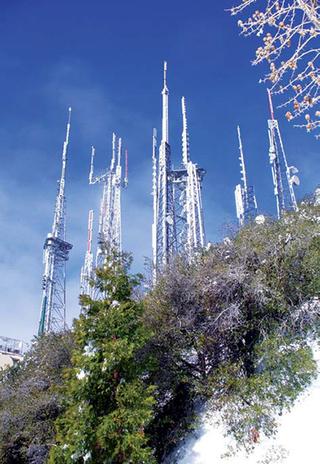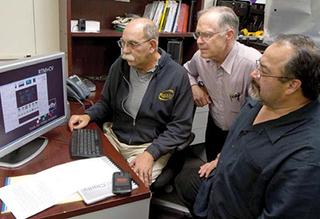L.A. Stations Decode Channel-Sharing Question

LOS ANGELES—The FCC and the CTIA-The Wireless Association believe that having two TV stations share the same 6 MHz of spectrum currently used by just one station will provide broadcasters what they need to do business and open up much desired spectrum for the wireless industry.
Right now they’re finding out if it can be successfully done.
“APTS reached out to us on behalf of our PBS community,” said Alan Popkin, director of engineering for participant station KLCS.
The Association for Public Television Stations is a lobbying group for the public television industry, and Popkin explained that APTS’ interest in the project was to further public television’s knowledge by investigating and evaluating the challenges and benefits of channel sharing.
“Public television stations have always embraced technology; they were the first to caption, use descriptive video and offer multicast services,” said Lonna Thompson, executive vice president, chief operating officer and general counsel for APTS.
Popkin said the reason KLCS and KJLA were chosen was due to their very different content models. KJLA serves the Hispanic minority population of Los Angeles and KLCS as a PBS station serves “the underserved.” Both agreed to participate because of their shared mission to serve their viewers. “What can you successfully put into a 19.39 Mbps channel and how do you do that with the best engineering practices?” Popkin articulated that this is a goal of both stations.
The technology to send multiple HD/SD signals down a single channel has been around for many years, but taking channels from two different stations and combining them created a whole host of unexpected challenges.
Get the TV Tech Newsletter
The professional video industry's #1 source for news, trends and product and tech information. Sign up below.

Mt. Wilson is home to KLCS and KJLA’s antennas. The first was to identify how to configure a Program and System Information Protocol table for multiple channels originating from two separate traffic systems. PSIPs manage both program and commercial content for each station. They needed to make sure the event information tables would parse out the proper program descriptions to the correct channels. What isn’t known is how many TVs will then be able to accurately display these.
Dane Eriksen, a consulting engineer who follows trends in RF for Hammett & Edison in San Francisco, is closely watching how the channel identification will be handled.
“Can the current PSIP code accommodate two primary channels, as opposed to just one primary channel and multiple secondary channels?” Ericksen asked. The KLCS-KJLA combination may try to fit both their 41.1-x and 49.1-x primary and subchannels into two virtual channels fed through a single program stream.
“Another concern is whether all receivers built to current ATSC standards will respond uniformly and if the PSIP can handle two virtual channels in one RF channel,” Ericksen added.
Also of interest is a test to encode and transmit H.264 content over the air. This is not part of the current ATSC spec, though many newer web-enabled TVs have H.264 decoders built in for streaming Internet content. The question is whether there is a way for the H.264 decoder to be accessed by the tuner, a technology solution that seems very possible. By enabling more efficient compression over the air, broadcasters could further expand their offerings to their viewers.
It also raised an interesting question to Popkin, “if H.264 works over the air, would broadcasters be able to get away with using a lower bandwidth MPEG-2 lifeline channel and then offer more H.264 streams?” This is a business and legal quandary that may arise should the tests prove successful.
The other business and legal issue that arises from changing current delivery bitrates and formats is how to handle retransmission agreements. This is the legal stipulation where a cable or satellite provider is supposed to be provided a signal of a specific quality for retransmission through their systems. Popkin does not see this as an issue, however. “To meet retrans rules, stations can provide other concurrent bitrates via video fiber or data circuits to the cable or satellite providers,” he said.
THE PARTNERSHIP
Broadcasters may have invented the original broadcast standards, but it is the electronics industry that today determines where the technology will go. Broadcasters basically have to broadcast to what the equipment will receive. This is an important reason for a productive partnership with the electronics industry.

(L to R) Alan Popkin and Roger Knipp of KLCS and Eddie Hernandez of KJLA monitor the results of the stations’ channel sharing experiment. “The CTIA funded the project with the latest encoder/ decoders for us to see what could be possible,” said Popkin, who added that many manufacturers and groups are directly involved in the overall experiment.
From manufacturers supplying their full range of TVs for reception testing, to PBS loaning their QoE measurement gear, there is a concerted effort by all parties to create a test that will result in data that can be used by all involved.
“As digital compression rates continue to improve, our stations will use their spectrum to offer diverse programming streams, and educational and public safety data streams, as well as other public services,” added APTS’s Thompson.
Because each test station is only licensed to broadcast specific content, as part of the testing they created a bench system that they could compare to the OTA broadcast chain. This was done to set a baseline for testing other more challenging material such as sports and other more bitrate-hungry video.
Popkin was pleased to discover that “we found no real degradation between over-theair and the test bed’s digital streams.” This gives his team the ability to truly try to first “break” the program stream on the bench system without affecting the over-the-air product.
Unlike cable and satellite media providers, broadcasters do not control both sides of the broadcast chain. If they want to add services or channels they cannot just send their customers a new box
“Broadcasters have a challenge in innovating, as they control just the send end of the pipe,” Popkin said. Thus broadcasters are at the mercy of the manufacturers and what functionality they will enable on their devices.
The mobile TV initiatives are good examples of this where a lack of receiving devices supporting their transmissions has led to limited adoption of the new offering. For broadcasters, moving forward in developing new technologies will require continued partnerships, more testing and the ability to inform and communicate their goals through the distracting chatter of government and industry lobbying groups.
DEVIL IN THE DETAILS?
The goal of the pilot program, announced in late January, is to show that if implemented in markets across the country—as part of the upcoming incentive auction of television broadcast spectrum—channel sharing would allow over-the-air broadcasters to continue providing—and enhancing—quality content without impacting their viewers while reducing infrastructure costs. Subsequently, the spectrum relinquished by those channel-sharing broadcasters would be auctioned with some of the proceeds going to those participating broadcasters to reinvest in services to benefit their communities.
In preparation for the testing, which is expected to wrap up this month, FCC Chairman Tom Wheeler recently visited KLCS (one of the two stations participating in the test, KJLA is the other), where he saw the station broadcast not only a single HD channel but also multiple SD channels on a single transmission path—an action he called “game changing.” He was not around for the next planned test which is to fit two primary HD channels onto that same path. But considering that public broadcaster WETA, which is in Wheeler’s own backyard in Washington, D.C., pioneered multicasting years ago with a single HD primary channel and multiple SD subchannels, this technical demonstration should have been no surprise. What Wheeler missed was in the details: The true technical goals of the tests, and how those results may affect and improve broadcasters’ ability to maximize the use of currently allotted spectrum.
Similarly, the CTIA began its press release saying the “goal of the program” was to show that squeezing two broadcasters into one channel would provide motivation for stations to broker deals in the incentive auctions to sell their spectrum to wireless providers. These are the auctions where the government hopes to make money by selling broadcaster allotted spectrum space to an eager and wealthy wireless industry.
This pro wireless stance once again renews the debate of the value of providing broadcasters use of spectrum and what truly benefits the public more. The FCC and CTIA view the desire for more wireless devices and services as justification for spectrum re-allocation, where broadcasters believe the public services they provide justify the status quo.
In a cautionary response to the project, the National Association of Broadcasters expressed concern that limiting spectrum access by channel sharing may limit the industry’s ability to “offer new and innovative services” that also will benefit the public.
Looking closer at what public station KLCS and commercial station KJLA are actually doing may supply data that will eventually benefit both wireless and broadcast industries. It not only demonstrates that a public/ private partnership can work, it also shows how advances in technology can overcome current technical challenges. This type of success may eventually provide solutions that will benefit both industries as well as the public.
The test group in Los Angeles hopes to present its results at the NAB Show next month.

